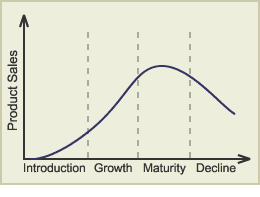Product Life Cycle Diagram

The product revenue and profits can be plotted as a function of the life-cycle stages as shown in the graph below:
Introduction Stage
In the introduction stage, the firm seeks to build product awareness and develop a market for the product. The impact on the marketing mix is as follows:
• Product branding and quality level is established and intellectual property protection such as patents and trademarks are obtained.
• Pricing may be low penetration pricing to build market share rapidly, or high skim pricing to recover development costs.
• Distribution is selective until consumers show acceptance of the product.
• Promotion is aimed at innovators and early adopters. Marketing communications seeks to build product awareness and to educate potential consumers about the product.
Growth Stage
In the growth stage, the firm seeks to build brand preference and increase market share.
• Product quality is maintained and additional features and support services may be added.
• Pricing is maintained as the firm enjoys increasing demand with little competition.
• Distribution channels are added as demand increases and customers accept the product.
• Promotion is aimed at a broader audience.
Maturity Stage
At maturity, the strong growth in sales diminishes. Competition may appear with similar products. The primary objective at this point is to defend market share while maximizing profit.
• Product features may be enhanced to differentiate the product from that of competitors.
• Pricing may be lower because of the new competition.
• Distribution becomes more intensive and incentives may be offered to encourage preference over competing products.
• Promotion emphasizes product differentiation.
Decline Stage
As sales decline, the firm has several options:
• Maintain the product, possibly rejuvenating it by adding new features and finding new uses.
• Harvest the product - reduce costs and continue to offer it, possibly to a loyal niche segment.
• Discontinue the product, liquidating remaining inventory or selling it to another firm that is willing to continue the product.
No comments:
Post a Comment